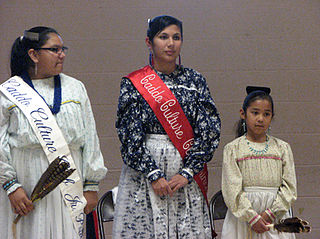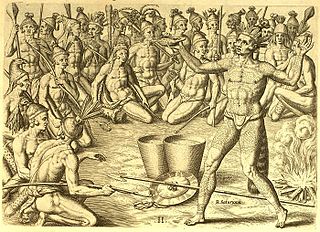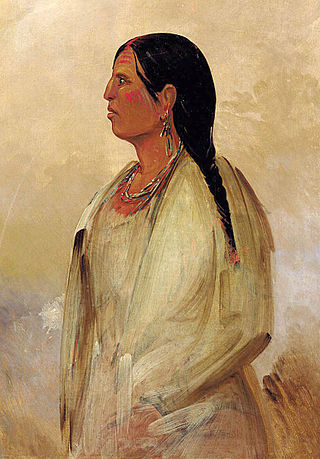
The Muscogee, also known as the Mvskoke, Muscogee Creek or just Creek, and the Muscogee Creek Confederacy, are a group of related Indigenous peoples of the Southeastern Woodlands in the United States. Their historical homelands are in what now comprises southern Tennessee, much of Alabama, western Georgia and parts of northern Florida.
Muscogee mythology is related to a Muscogee tribe who are originally from the southeastern United States, also known by their original name Mvskoke, the name they use to identify themselves today. Mvskoke is their name in traditional spelling. Modern Muscogees live primarily in Oklahoma, Alabama, Georgia, and Florida. Their language, Mvskoke, is a member of the Eastern branch of the Muskogean language family. The Seminole are close kin to the Mvskoke and speak an Eastern Muskogean language as well. The Muscogee were considered one of the Five Civilized Tribes. After the Creek War many of the Muscogee escaped to Florida to create the Seminole.

The term Five Civilized Tribes was applied by the United States government in the early federal period of the history of the United States to the five major Native American nations in the Southeast: the Cherokee, Chickasaw, Choctaw, Muscogee (Creek), and Seminoles. White Americans classified them as "civilized" because they had adopted attributes of the Anglo-American culture.

The Seminole are a Native American people who developed in Florida in the 18th century. Today, they live in Oklahoma and Florida, and comprise three federally recognized tribes: the Seminole Nation of Oklahoma, the Seminole Tribe of Florida, and the Miccosukee Tribe of Indians of Florida, as well as independent groups. The Seminole people emerged in a process of ethnogenesis from various Native American groups who settled in Spanish Florida beginning in the early 1700s, most significantly northern Muscogee Creeks from what are now Georgia and Alabama.

The Caddo people comprise the Caddo Nation of Oklahoma, a federally recognized tribe headquartered in Binger, Oklahoma. They speak the Caddo language.

Ocmulgee Mounds National Historical Park in Macon, Georgia, United States preserves traces of over ten millennia of culture from the Native Americans in the Southeastern Woodlands. Its chief remains are major earthworks built before 1000 CE by the South Appalachian Mississippian culture These include the Great Temple and other ceremonial mounds, a burial mound, and defensive trenches. They represented highly skilled engineering techniques and soil knowledge, and the organization of many laborers. The site has evidence of "12,000 years of continuous human habitation." The 3,336-acre (13.50 km2) park is located on the east bank of the Ocmulgee River. Macon, Georgia developed around the site after the United States built Fort Benjamin Hawkins nearby in 1806 to support trading with Native Americans.

The Yuchi people, also spelled Euchee and Uchee, are a Native American tribe based in Oklahoma. Their original homeland was in the southeast of the present United States.

Black drink is a name for several kinds of ritual beverages brewed by Native Americans in the Southeastern United States. Traditional ceremonial people of the Yuchi, Caddo, Chickasaw, Cherokee, Choctaw, Muscogee and some other Indigenous peoples of the Southeastern Woodlands used the black drink in purification ceremonies. It was occasionally known as white drink because of the association of the color white with peace leaders in some Native cultures in the Southeast.

Indigenous peoples of the Southeastern Woodlands, Southeastern cultures, or Southeast Indians are an ethnographic classification for Native Americans who have traditionally inhabited the area now part of the Southeastern United States and the northeastern border of Mexico, that share common cultural traits. This classification is a part of the Eastern Woodlands. The concept of a southeastern cultural region was developed by anthropologists, beginning with Otis Mason and Franz Boas in 1887. The boundaries of the region are defined more by shared cultural traits than by geographic distinctions. Because the cultures gradually instead of abruptly shift into Plains, Prairie, or Northeastern Woodlands cultures, scholars do not always agree on the exact limits of the Southeastern Woodland culture region. Shawnee, Powhatan, Waco, Tawakoni, Tonkawa, Karankawa, Quapaw, and Mosopelea are usually seen as marginally southeastern and their traditional lands represent the borders of the cultural region.

The stomp dance is performed by various Eastern Woodland tribes and Native American communities in the United States, including the Muscogee, Yuchi, Cherokee, Chickasaw, Choctaw, Delaware, Miami, Caddo, Tuscarora, Ottawa, Quapaw, Peoria, Shawnee, Seminole, Natchez, and Seneca-Cayuga tribes. Stomp dance communities are active in Georgia, North Carolina, Oklahoma, Alabama, Mississippi, and Florida.

Cherokee society is the culture and societal structures shared by the Cherokee People. It can also mean the extended family or village. The Cherokee people are Indigenous to the mountain and inland regions of the southeastern United States in the areas of present-day North Carolina, and historically in South Carolina, Tennessee, Virginia, and Northern Mountainous areas, now called the Blue Ridge Mountains of Georgia and its lowlands. The majority of the tribe was forcibly removed to Indian Territory in the winter of 1838-1839.

Aztec cuisine is the cuisine of the former Aztec Empire and the Nahua peoples of the Valley of Mexico prior to European contact in 1519.

Town Creek Indian Mound is a prehistoric Native American archaeological site located near present-day Mount Gilead, Montgomery County, North Carolina, in the United States. The site, whose main features are a platform mound with a surrounding village and wooden defensive palisade, was built by the Pee Dee, a South Appalachian Mississippian culture people that developed in the region as early as 980 CE. They thrived in the Pee Dee River region of North and South Carolina during the Pre-Columbian era. The Town Creek site was an important ceremonial site occupied from about 1150—1400 CE. It was abandoned for unknown reasons. It is the only ceremonial mound and village center of the Pee Dee located within North Carolina.

The Seminole Nation of Oklahoma is a federally recognized Native American tribe based in the U.S. state of Oklahoma. It is the largest of the three federally recognized Seminole governments, which include the Seminole Tribe of Florida and the Miccosukee Tribe of Indians of Florida. Its citizens are descendants of the approximately 3,000 Seminoles who were forcibly removed from Florida to Indian Territory, along with 800 Black Seminoles, after the Second Seminole War. The Seminole Nation of Oklahoma is headquartered in Wewoka within Seminole County, Oklahoma. Of 18,800 enrolled tribal citizens, 13,533 live in Oklahoma. The tribe began to revive its government in 1936 under the Indian Reorganization Act. While its reservation was originally larger, today the tribal reservation and jurisdictional area covers Seminole County, Oklahoma, within which it has a variety of properties.
The Four Mothers Society or Four Mothers Nation is a religious, political, and traditionalist organization of Muscogee Creek, Cherokee, Choctaw and Chickasaw people, as well as the Natchez people enrolled in these tribes, in Oklahoma. It was formed in the 1890s as an opposition movement to the allotment policies of the Dawes Commission and various US Congressional acts of the period. The society is religious in nature. It opposed allotment because dividing tribal communal lands attacked the basis of their culture. In addition, some communal lands would be declared surplus and likely sold to non-Natives, causing the loss of their lands.

Josie Billie was a Mikasuki-speaking Seminole medicine man, doctor, and Baptist preacher. Billie was a member of the Panther clan of the Seminoles in southern Florida. He actively collaborated with American anthropologists and researchers like Ethel Cutler Freeman, Frances Densmore, Robert Greenlee, Robert Solenberger and William Sturtevant. Billie served as a public spokesman for the Florida Seminoles and created recordings of traditional folk songs and information about the traditional Seminole religion. As of 2017, his camp is part of the Tribal Register of Historic Places.















